Grand Rapids, Michigan
Grand Rapids has two Lithuanian cemeteries, three clubs and a church - all of them over a century old and yet all of them still operating. This tenacity of the old Lithuanian district makes Grand Rapids unique among American cities of such size.
Grand Rapids Lithuanian church and parish
While in many Lithuanian districts, it is the church that holds the most Lithuanian decorations, Grand Rapids Ss. Peter and Paul church, while rather large, lacks Lithuanian details. Constructed in the 1920s to replace a smaller church-school, the church was renovated in the 1960s and repainted in the 1980s. The 1960s refurbishment simplified the altar, while the 1980s refurbishment removed the Lithuanian inscriptions under the stations of the cross. According to the priest Dennis Morrow of the church, in Grand Rapids, unlike in many other Lithuanian parishes, the post-WW2 refugees did not overwhelm the entire community and thus their calls for more ethnic detail in the church went unheard. Furthermore, the church never had traditionally opulent historic stained glass windows, so rather simple ones were installed in the 1960s.
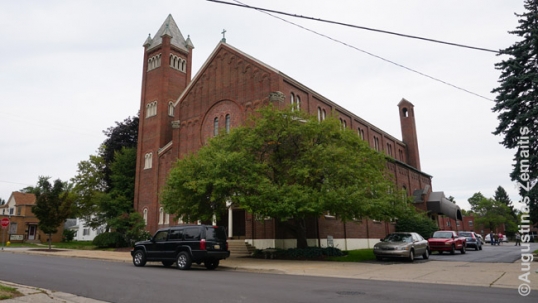
Grand Rapids Ss. Peter and Paul Lithuanian church

Interior of the Ss. Peter and Paul Lithuanian church
The only Lithuanian details at the church can be found at the World War 2 veterans memorial nearby, which has Vytis (Lithuanian coat of arms) on it.

Lithuanian World War 2 veterans memorial

Vytis on the memorial
The large buildings further on used to house a parish school and a convent (built in 1964), however, currently these are closed and they are used only for parish events.
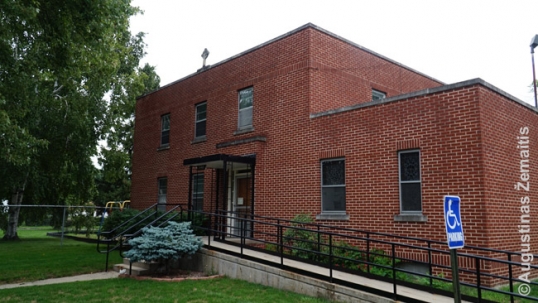
Lithuanian school of Grand Rapids
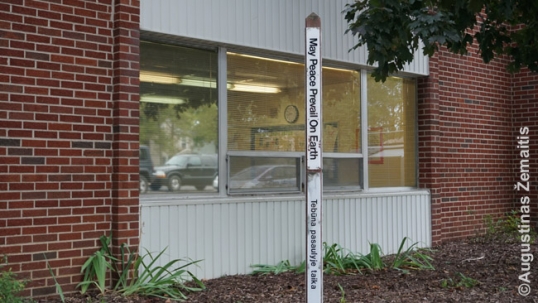
The multi-lingual sign (also Lithuanian) at the Lithuanian school
A bench in front of the church has been built to commemorate priest Dennis Morrow of Lithuanian descent.
Grand Rapids Lithuanian clubs
Grand Rapids has three Lithuanian clubs. These clubs also double as members-only bars (although non-members may be able to come in as well).
The most well-known one is the Vytautas Kareivis Aid Society, established in 1910. Its building sports a Lithuanian flag and symbols. Inside, it has a bar and a Heritage room. Among the Lithuanian memorabilia there one can find a military uniform. At its beginning and long after that, Vytautas Aid Society was a paramilitary organization and its members used to march the American streets in these Lithuanian uniforms. Eventually, the Society changed. For example, well until the 1980s there was a requirement that a person who joins must be a Lithuanian through a paternal line (i.e. have a Lithuanian surname) but now a maternal line is also acceptable and women are allowed to join. Non-Lithuanians may join as associate members and since 2000s, non-Catholics are allowed to join as well. Only the Lithuanians could become full members, however. Vytautas Aid Society has some 450 members, 125 of whom are full members (2023).
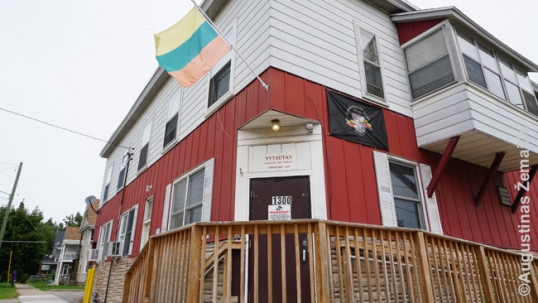
Vytautas Kareivis Aid Society building

Vytautas Kareivis Aid Society members posing with their uniforms (image from the Society's heritage rooms)
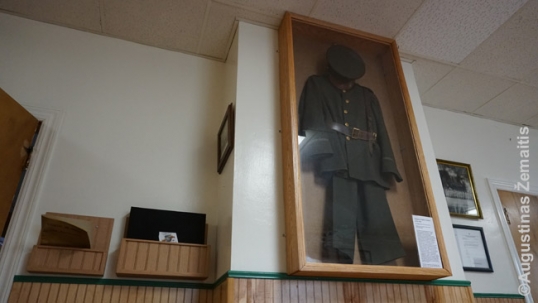
Vytautas Kareivis Aid Society uniform at the Society's heritage rooms
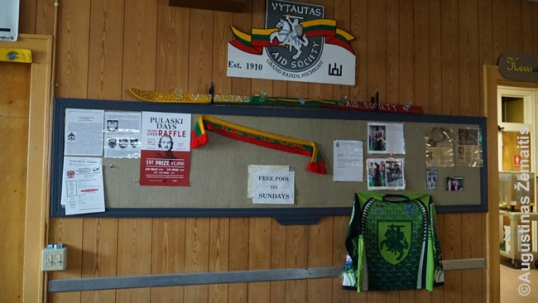
Inside the Vytautas Kareivis Aid Society
Less well known is the Lithuanian Sons and Daughters Association (est. 1909, building constructed in 1913). Its building has "Lyceum Lithuanian Sons Aid Society" inscribed on it, as the inscription was made at the time the organization was men only (females have been admitted since 1921 after bi-gender Historicist Daukantas society merged into it). While the Vytautas Kareivis Aid Society historically represents the patriots/nationalists, Lithuanian Sons and Daughters represented the leftists and communists. As such, the organization was shunned by most Lithuanians after the Soviet occupation of Lithuania and many people in both the church and the Vytautas Aid Society claim that their parents would advise them not to go to the Lithuanian Sons and Daughters. Today, however, Lithuanian Sons and Daughters members claim their organization is non-political, so much of the rivalry is historical. As a leftist organization, Lithuanian Sons and Daughters amassed less Lithuanian memorabilia and, in fact, in the modern times, it is sometimes referred to as just "Sons and Daughters", while Polish heritage seems to be at least as celebrated as Lithuanian heritage. It has images of its founding members (1913), 20th-anniversary members (1929) and Simonas Daukantas near its streetside entrance (it is interesting to understand that these images hang there since the time World War 1 had not yet begun and Lithuania was ruled by the czar). The main entrance is behind. The hall on the second floor is big but it has no Lithuanian details (although originally, it had been painted with murals showing Lithuanian countryside). It has some 150 members of whom 150 are active (2018).

Lithuanian Sons and Daughters club of Grand Rapids
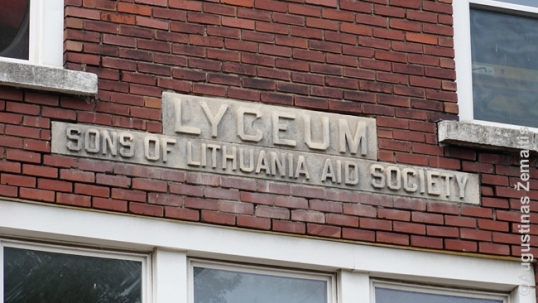
"Lithuanian Sons" inscription on the club
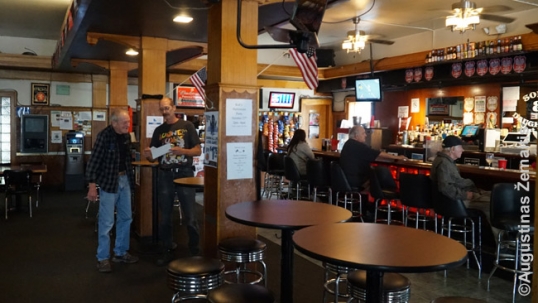
Interior of the Lithuanian Sons and Daughters club
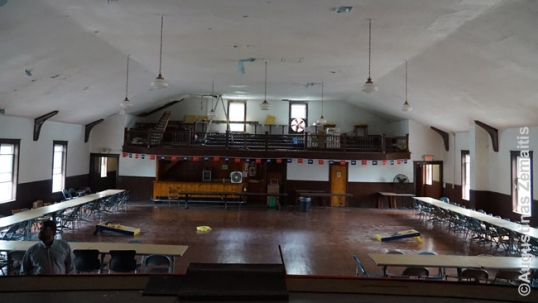
2nd floor hall of the Lithuanian Sons and Daughters club that used to be decorated in images of Lithuanian countryside
Predating the two secular Lithuanian societies were two Catholic Lithuanian societies: the Ss. Peter and Paul aid society (est. 1891) and St. George Aid Society (est. 1903). Both have also erected their clubhouses: Ss. Peter and Paul Aid Society in 1902 and St. George's Aid Society in 1907 (renovated in 1949). Both buildings still stand, however, Ss. Peter and Paul building is no longer used for the original purpose. That is because in 1964 both societies merged into one and use only the St. George building (now titled as St. George's, St. Peter and Paul Aid Society). While neither of the two buildings has any external Lithuanian details, the St. George's building has Lithuanian memorabilia inside, including Lithuanian flag, Vytis symbols, while its mugs are adorned by the Lithuanian coat of arms. St. George Society has 700 members, having rebounded from 50 at its lower point. Its clubhouse is two0floored, with the lower floor serving as a bar and the upper floor as a members-space and rental hall, hosting up to 250 people.

St. George Aid Society
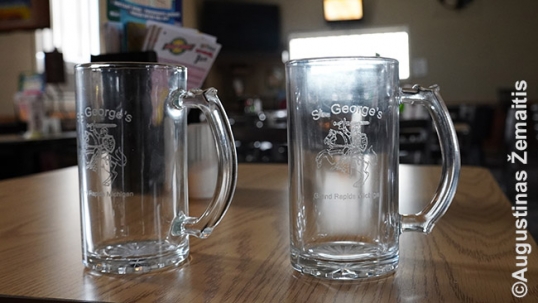
The mugs of St. George's Aid Society
The "Aid Societies" typically were called so because they all initially acted also as charitable organizations to both their members and non-members. In the early days, support for members in times of need was especially important, as, at the time, there were no social guarantees, so the only way immigrants could ensure that they would not be left to poverty in case they get hurt in the job, for example, was to join such organizations where the well-off members would help their less well-off co-nationals. Vytautas Kareivis Aid Society especially continues this charitable mission, regularly supporting both Lithuanian and non-Lithuanian institutions of Grand Rapids. Nowadays, however, these societies also serve as ethnically-themed bars, and Grand Rapids has a culture behind such places, with its apex during the annual Pulaski days when it is common to visit many such historic ethnic clubs.
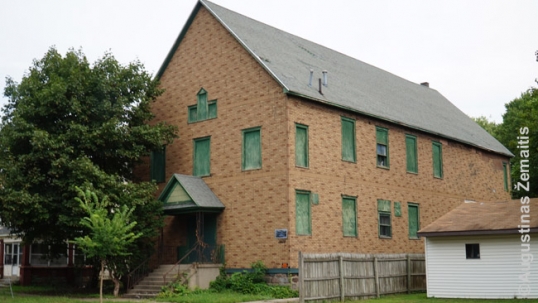
Former Lithuanian Ss. Peter and Paul Catholic aid society near the Ss. Peter and Paul Church

St. George Aid Society building, now operating as a united St. George's St. Peter and Paul Aid Society
Grand Rapids Lithuanian cemeteries
The main Grand Rapids Lithuanian cemetery is the rather large Ss. Peter and Paul cemetery. Two of the most impressive memorials here is the Traditional Lithuanian wooden cross of 1987 (author Jurgis Daugvila), dedicated to the Lithuanian 600 years Christianization anniversary, and the Memorial for Lithuanian priests, dedicated in 1979. The priest's memorial symbolizes a Divine Invitation - to the priesthood, life, death.
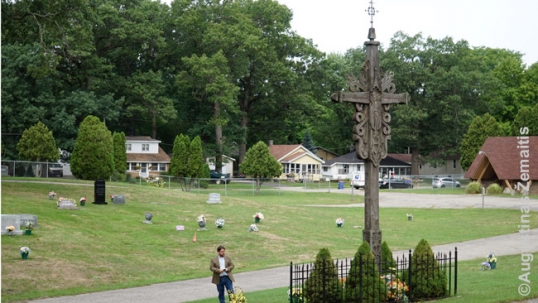
600th anniversary of Lithuanian Christianity cross in the Ss. Peter and Paul Lithuanian cemetery
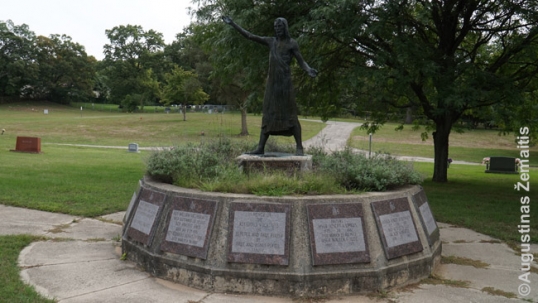
Memorial to the Lithuanian priests of Grand Rapids
Just beyond a fence (but with an entrance from the other side) lies the other Lithuanian cemetery of Grand Rapids: the Lithuanian Freedom Cemetery. It is small, only the plaque at the entrance and many surnames show it to be Lithuanian. There, socialists and non-believers used to be buried. According to the local priest Morrow, no more than 15% of total Lithuanians. At the later stages of the cemetery, the priest would have been invited to some burials as some people wanted to bury themselves next to their kin even though they became believers. Interestingly, some of the graves in the Freedom Cemetery are located away from the other graves and right beyond the fence of the Lithuanian Catholic Ss. Peter and Paul Cemetery, facing the Catholic cemetery, perhaps signifying that these people were denied burial at the Catholic cemetery for some reason despite wishing for it.

Lithuanian non-religious cemetery entrance

Some of the graves at the Freedom cemetery that are facing the fence between the cemeteries. The Ss. Peter and Paul cemetery is beyond the fence
The map
All the Lithuanian locations, described in this article, are marked on this interactive map, made by the "Destination Lithuanian America" expedition (click the link):




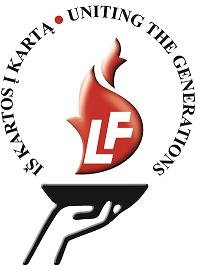

November 22nd, 2020 - 23:06
I remember going to the Sons and Daughters Club as a young boy with my parents, Joesph Yurgaitis & Adell.. Also my grandmother was a member and had her funeral celebration at the Hall.
August 23rd, 2021 - 23:18
My father, Felix Novitsky, often played cards and drank a few beers at Vytautas Kareivis Aid Society which he just called Kareivis. He was a proud Lithuanian and Democrat. I went with him a number of times and remember the strong smell of beer. It seemed like a friendly place and my father told me once that if my mother died before he did, he would give all his money to me and my brother except for enough for him to get a room above Kareivis so that he could play cards, drink some beer, and go fishing whenever he wanted. He was a great guy. Started life as a coal miner’s son in Pennsylvania and died on vacation in Hawaii. A real success story. Love you Dad.